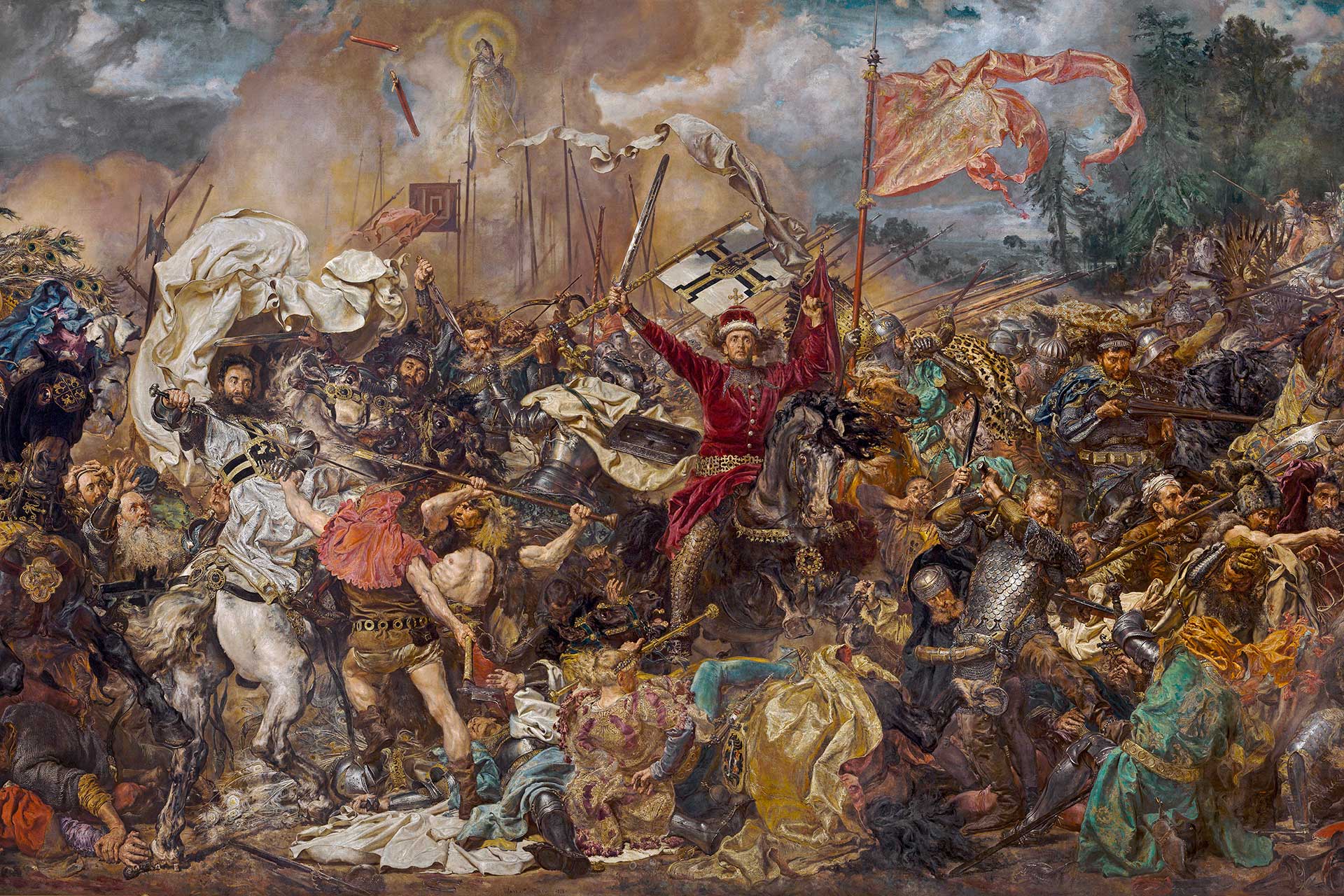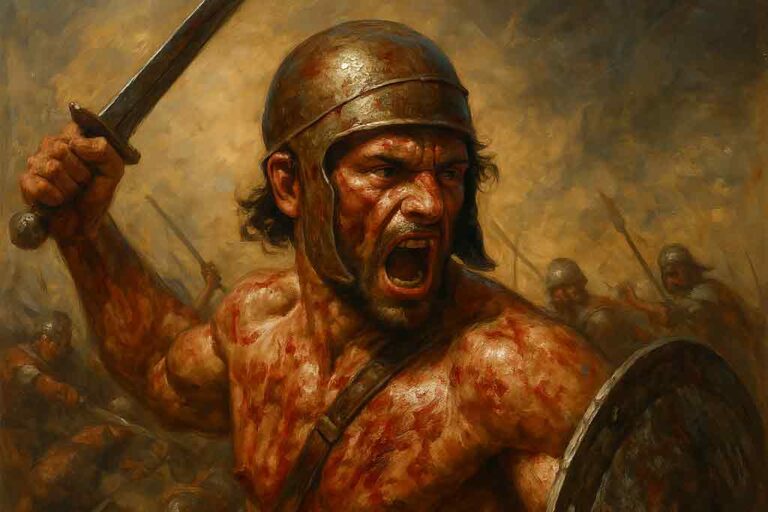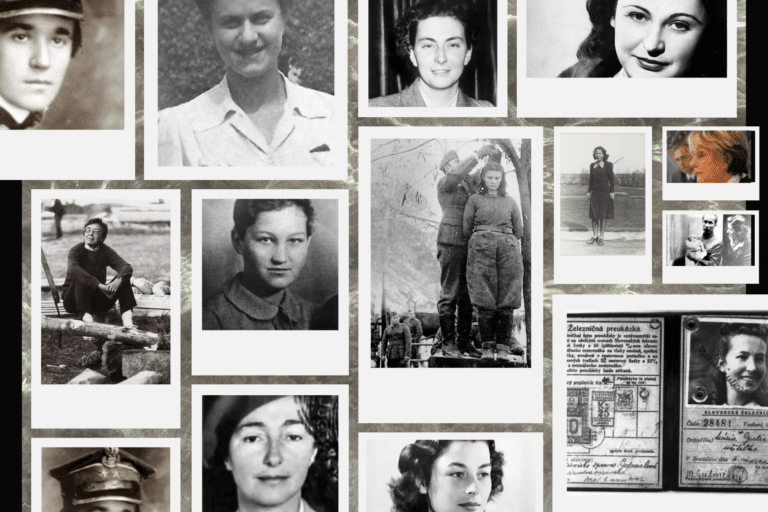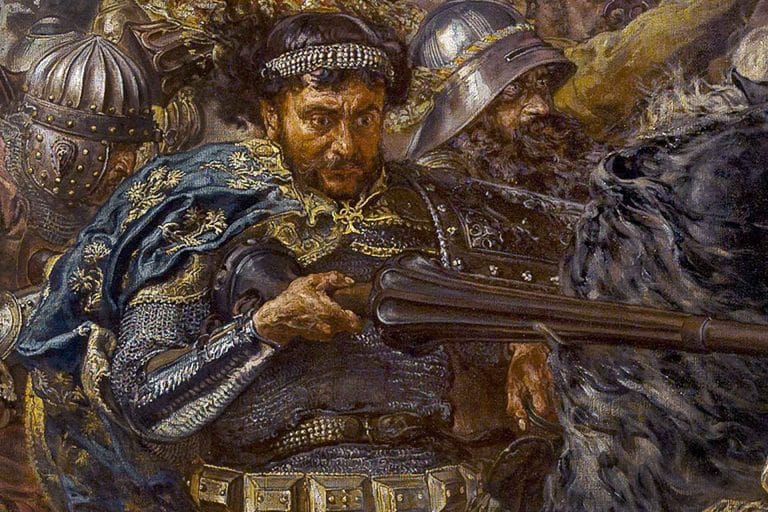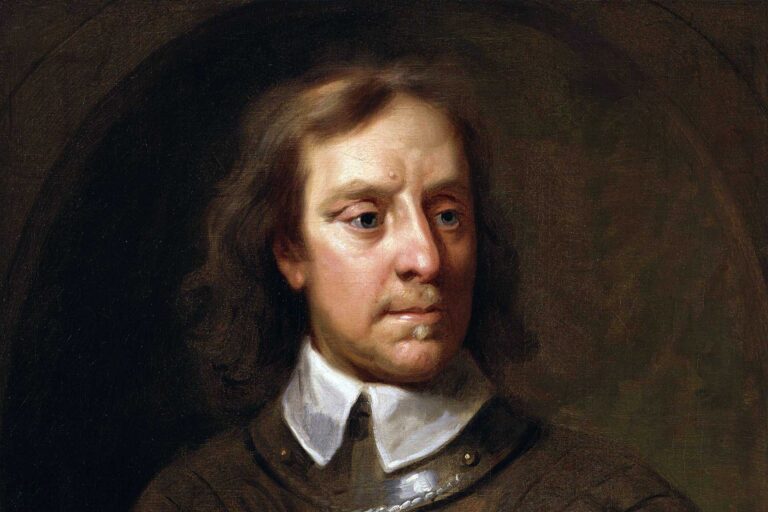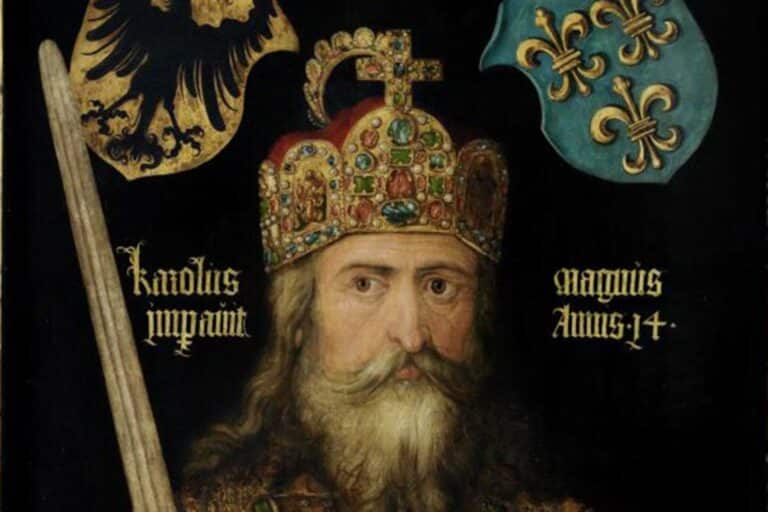The Battle of Grunwald: The Crusade That Broke the Teutonic Knights
On July 15, 1410, the fields near the villages of Grunwald and Tannenberg became the stage for one of medieval Europe’s most significant and pivotal battles. The Battle of Grunwald, also known as the First Battle of Tannenberg, saw the allied forces of the Kingdom of Poland and the Grand Duchy of Lithuania face off against the formidable Teutonic Knights.
This clash was not merely a military engagement but a culmination of longstanding religious and territorial conflicts that had simmered for over a century. It marked a critical turning point, fundamentally altering the trajectory of the Teutonic Order‘s influence in Eastern Europe.
Prelude to the Battle of Grunwald: Tensions and Alliances
In the early 13th century, the Teutonic Knights, a crusading military order, commenced the Prussian Crusade against the pagan Prussian clans. Endowed with the backing of the pope and the Holy Roman Emperor, they swiftly subjugated the Prussians, achieving complete control by the 1280s. Post-conquest, their crusading zeal redirected towards the pagan Grand Duchy of Lithuania, igniting a century of raids primarily aimed at Samogitia, a strategic region essential for linking their territories in Prussia and Livonia.
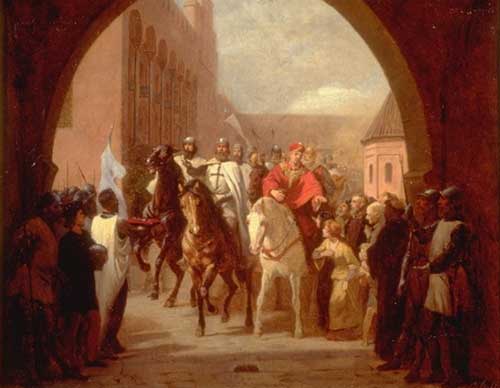
By 1385, the landscape of Eastern European politics transformed significantly with the Union of Kreva, where Grand Duke Jogaila of Lithuania wed Queen Jadwiga of Poland. Jogaila’s conversion to Christianity and subsequent crowning as King Władysław II Jagiełło of Poland established a personal union between Poland and Lithuania. This union consolidated their might and undermined the Teutonic Knights’ religious justification for their military campaigns against Lithuania.
The ongoing strife over territories like Samogitia continued to fuel hostilities. Despite the formal Christianization of Lithuania, the Teutonic Knights, led by Grand Master Conrad Zöllner von Rothenstein, challenged the sincerity of Jogaila’s conversion, escalating the conflict to a papal court. Meanwhile, territorial disputes and control over vital trade routes via major rivers exacerbated the tensions, setting the stage for a decisive confrontation.
Prelude to Battle: The Road to Grunwald
In May 1409, a spark in Samogitia ignited a broader conflict that would culminate in the historic Battle of Grunwald. A rebellion against the Teutonic Order’s rule in this Lithuanian-held territory quickly escalated as Lithuania supported the insurgents. The Teutonic Knights threatened invasion, prompting Poland to declare its backing of Lithuania, further intensifying the situation. This mutual support laid the groundwork for larger hostilities, as the Order’s Grand Master, Ulrich von Jungingen, officially declared war on the Kingdom of Poland and the Grand Duchy of Lithuania on August 6, 1409.
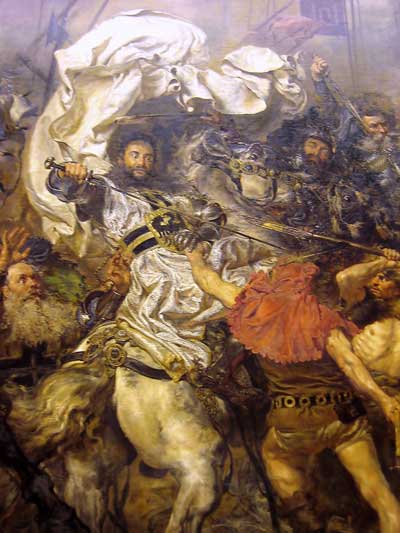
The Teutonic Knights embarked on a strategic offensive to catch Poland and Lithuania off guard by targeting Greater Poland and Kuyavia first. They managed to capture and sack several towns, including Bydgoszcz, while the Polish forces scrambled to organize effective counterattacks. This initial success for the Order was short-lived, as the Polish forces swiftly recaptured Bydgoszcz. Meanwhile, the Samogitians expanded the conflict by attacking Memel (Klaipėda), indicating that neither side was ready to back down or capable of a decisive blow.
King Wenceslaus of the Romans stepped in as a mediator, leading to a truce signed on October 8, 1409, which was to expire by June 24, 1410. Both parties used this pause not for peace but to prepare for the inevitable war. They gathered forces and secured alliances, with the Teutonic Order even securing a declaration from Wenceslaus that Samogitia rightfully belonged to them, thanks to substantial monetary gifts. However, they also faced diplomatic challenges, as the Polish-Lithuanian alliance proved resilient, thwarting attempts by Sigismund of Hungary to sow discord between the allies.
As the truce neared its end, the strategic planning of Władysław II Jagiełło and Vytautas came to the forefront. They decided on a bold move: to unite their forces and march directly towards Marienburg (Malbork), the capital of the Teutonic Order. This plan significantly shifted from the expected tactics and aimed to catch the Order off guard. To maintain the element of surprise, they continued to conduct raids along the border, keeping Teutonic forces stretched and uncertain of the main thrust of the impending attack. This intro to Battle of Grunwald set the stage for one of the most defining moments in the history of Eastern Europe.
The Armies of Grunwald: Composition and Allies
The Battle of Grunwald, one of the most significant medieval battles, was characterized by a massive assembly of forces across Europe. Yet, historical records regarding the exact numbers still need to be discovered. Contemporary sources failed to provide reliable troop counts, leading to varying estimates heavily influenced by nationalistic biases. According to Polish historian Stefan Kuczyński, often cited in Western literature, the Polish-Lithuanian alliance might have fielded around 39,000 troops, while the Teutonic Knights rallied around 27,000 men. These figures encompass a mix of cavalry, infantry, including pikemen and archers, and even some artillery units, though the exact composition under each banner remains undocumented.
Despite being outnumbered, the Teutonic Knights boasted superior discipline, training, and equipment, with their force notably including a formidable contingent of heavy cavalry. Although only a fraction of the Teutonic force comprised these heavily armored knights, their military prowess was augmented by advanced weaponry like bombards capable of launching lead and stone projectiles. This technological edge was critical to their battle strategy, aiming to counterbalance the numerical superiority of their adversaries.
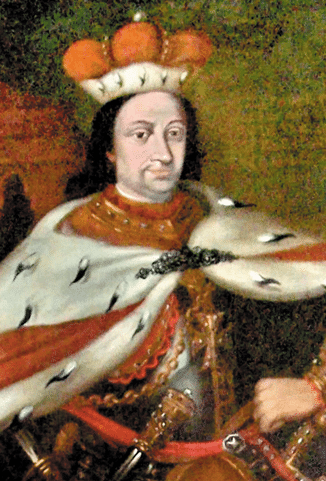
The armies were notably diverse, comprising mercenaries and allies from numerous European states. The Teutonic Order drew support from regions including Westphalia, Frisia, Austria, Swabia, and Bavaria, with notable figures like Nicholas II Garai and Stibor of Stiboricz from Hungary contributing troops. Conversely, the Polish-Lithuanian force included mercenaries from Moravia and Bohemia, with potential participation from the future Hussite commander Jan Žižka. Noteworthy was the involvement of Alexander I of Moldavia, who commanded an expeditionary corps and was honored for his courage with the prestigious royal sword, the Szczerbiec.
The command structures of both armies reflected their complex compositions. The Teutonic Knights’ forces were centrally managed, focusing on a disciplined and unified approach. On the other hand, the Polish-Lithuanian alliance, led by King Władysław II Jagiełło and actively commanded in the field by Grand Duke Vytautas, showcased a more federated command, integrating various national contingents while maintaining cohesive operational goals.
Vytautas’s direct involvement in the battle was pivotal, underscoring his crucial role in both leadership and tactical execution on the battlefield. This strategic orchestration of diverse forces under a unified command was instrumental in confronting and overcoming the disciplined ranks of the Teutonic Knights at Grunwald.
The Strategic March to Grunwald
The march to Grunwald began with a well-coordinated assembly of the Polish-Lithuanian forces, setting the stage for what would be one of the most significant battles in medieval European history. The initial gathering of troops occurred at Czerwińsk, approximately 80 kilometers from the Prussian border. This location served as the strategic point for crossing the Vistula River via a pontoon bridge, a maneuver completed between June 24 and 30. The Polish contingents from Greater Poland converged in Poznań, while those from Lesser Poland assembled in Wolbórz. On June 24, King Władysław II Jagiełło, accompanied by Czech mercenaries, arrived in Wolbórz, and three days later, they reached the designated meeting point, synchronizing their arrival with the Lithuanian forces, which had departed Vilnius on June 3.
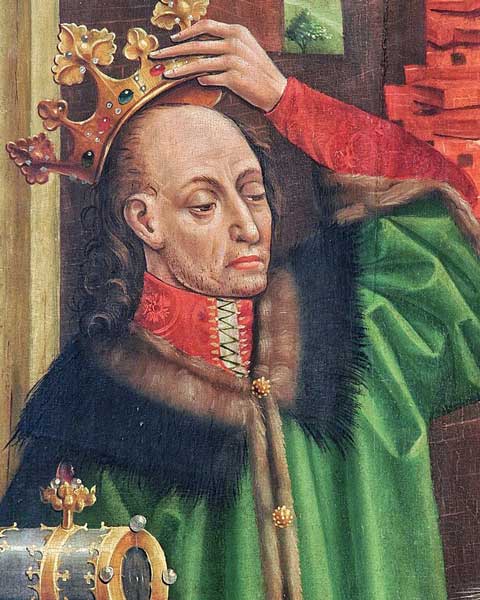
As the Allied forces prepared for their northward march towards Marienburg (Malbork), the capital of Prussia, they maintained secrecy, which was crucial for achieving strategic surprise. However, their movement was eventually disclosed by Hungarian envoys engaged in peace negotiations.
Upon learning of the Polish-Lithuanian intentions, Grand Master Ulrich von Jungingen of the Teutonic Knights quickly reacted by positioning 3,000 men at Schwetz (Świecie) and organizing his main force along the Drewenz River (Drwęca), creating a fortified defensive line. Despite encountering a heavily fortified crossing at Kauernik (Kurzętnik), King Władysław II Jagiełło, after a council with his war leaders on July 11, decided to bypass this obstacle by marching east towards the river’s sources. This maneuver avoided confrontation at the river and kept the route to Marienburg clear, underlining the strategic depth of the Polish-Lithuanian military planning.
The Opening Moves of the Battle of Grunwald
On the morning of July 15, 1410, the fields between Grunwald, Tannenberg (Stębark), and Ludwigsdorf (Łodwigowo) bristled with the anticipation of battle. Spanning approximately 4 square kilometers, this battleground saw the amassed forces of the Polish-Lithuanian alliance and the Teutonic Knights face off. The armies aligned along a northeast-southwest axis, with the Polish-Lithuanian troops positioned to the east of Ludwigsdorf and Tannenberg. The formation featured the Polish heavy cavalry on the left flank, Lithuanian light cavalry on the right, and a central corps of diverse mercenary troops. These forces were arranged in three lines, forming deep wedge-shaped formations poised for the clash.

Under the command of Grand Marshal Frederic von Wallenrode, the Teutonic Knights focused their elite heavy cavalry against the Lithuanians, hoping to provoke an early attack from their opponents. As the morning progressed, the heavily armored Teutonic troops endured the sweltering sun, forming a static line that awaited the initiation of combat. Amidst a light rain, their attempt to leverage field artillery was thwarted as dampened gunpowder limited them to only two cannon shots. Adding to the tension, the Grand Master of the Teutonic Order sent messengers delivering two swords to King Władysław II Jagiełło and Grand Duke Vytautas, a gesture intended as an insult to provoke the allied forces into action. These “Grunwald Swords” would later symbolize Polish defiance and courage.
The battle commenced with Vytautas leading a vigorous assault on the Teutonic left flank. This intense engagement persisted for over an hour until the Lithuanian light cavalry, possibly overwhelmed, commenced a full retreat. Chronicler Jan Długosz described this moment as a catastrophic disintegration of the Lithuanian forces, leading the Teutonic Knights to believe they had clinched victory. However, this perception was premature, as the Knights disrupted their formation to chase the retreating Lithuanians—a move that would later have significant consequences.
Contrary to Długosz’s account, which highlighted a predominantly Polish resistance, other historical sources, and modern interpretations suggest that the Lithuanian withdrawal was a tactical feint, perhaps inspired by similar maneuvers used by the Golden Horde. This feigned retreat tactic, meant to lure the enemy into a vulnerable pursuit, set the stage for a dramatic and decisive counterattack later in the battle.
The Turning Tides at the Battle of Grunwald

Intense combat ensued between the Polish units and the Teutonic Knights as the Lithuanian forces executed their retreat. The Teutonic troops, led by Grand Komtur Kuno von Lichtenstein, concentrated onoverpowering the Polish right flank. This part of the battlefield witnessed the heart of the Teutonic offensive, with six of von Walenrode’s banners redirecting from the retreating Lithuanians to join the fierce engagement against the Poles. Amid the chaos, the royal Kraków banner, a significant symbol of Polish resistance, was momentarily captured when its standard-bearer, Marcin of Wrocimowice, was overcome. However, the banner was swiftly recaptured, symbolizing the resilience and unyielding spirit of the Polish troops.
In response to the escalating threat, King Władysław II Jagiełło made a decisive move by deploying the second line of reserves, intensifying the Polish counter-efforts. Recognizing the critical situation, Grand Master Ulrich von Jungingen personally led a formidable charge with 16 banners, nearly a third of the Teutonic original strength, towards the embattled Polish right flank. This aggressive push by the Grand Master aimed to break the Polish lines and tilt the battle in favor of the Teutonic Knights. In turn, Jagiełło countered by deploying his final reserves, the third line of the army, as the battle’s intensity peaked near the Polish command post.
The conflict reached a dramatic climax when a Teutonic knight, identified as Lupold or Diepold of Kökeritz, launched a direct assault on King Władysław II Jagiełło himself. In a crucial moment that could have altered the course of the battle, the king’s secretary, Zbigniew Oleśnicki, intervened, thwarting the attack and saving the king’s life. This act of bravery not only preserved the Polish leadership but also elevated Oleśnicki to a position of significant influence within the kingdom. This sequence of events marked a pivotal phase in the Battle of Grunwald, setting the stage for the dramatic final maneuvers that would determine the fate of the Teutonic Knights.
The Decisive Endgame at Grunwald
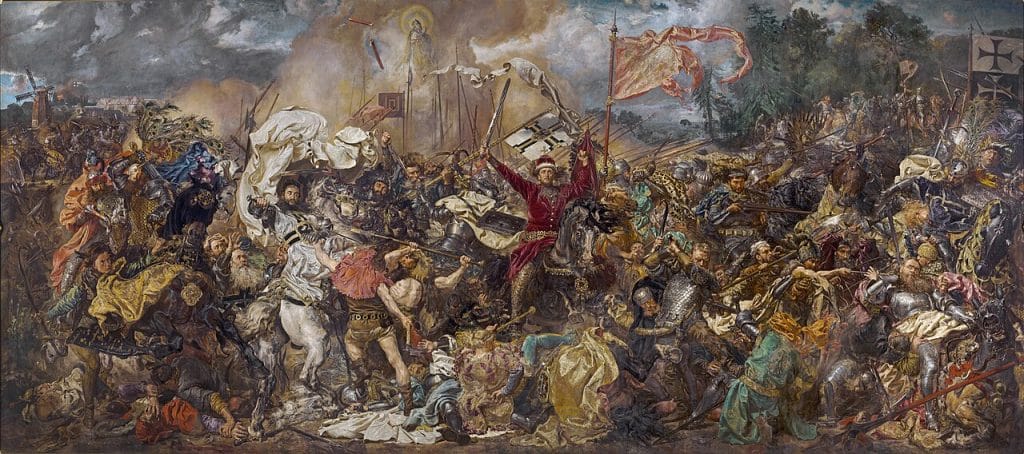
As the battle climaxed, the reorganized Lithuanian forces, previously feigned in retreat, made a critical reentry into the fray. They launched a surprising assault on the Teutonic Knights from the rear, catching the already engaged Teutons off guard. This maneuver was a turning point, dramatically shifting the balance as the Polish knights and the Lithuanian cavalry combined began to overwhelm the Teutonic lines. Amid the chaos, Grand Master Ulrich von Jungingen, leading his troops in an attempt to break through the Lithuanian ranks, met his demise. Historical accounts vary, with one chronicler naming Dobiesław of Oleśnica as the knight who fatally wounded von Jungingen, while another attributes the critical blow to Mszczuj of Skrzynno.
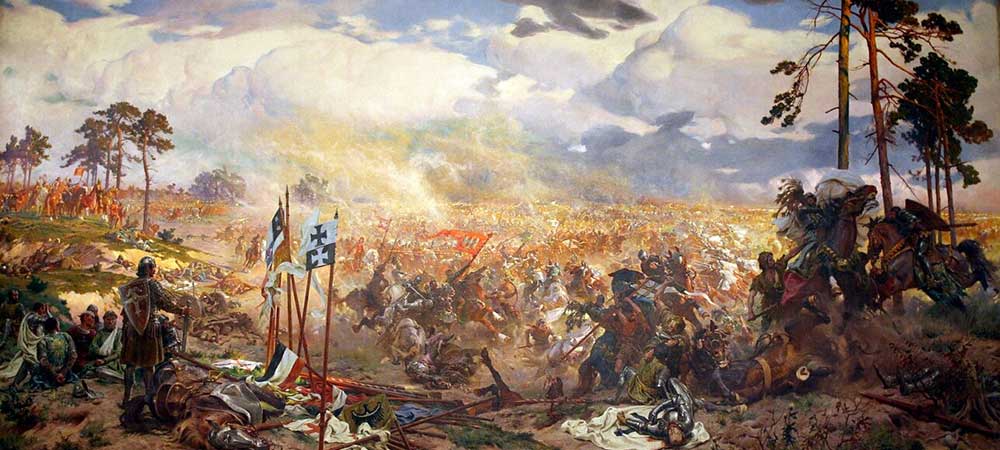
Zawisza the Black, a legendary Polish knight and national hero, played a prominent role in the Battle of Grunwald, contributing to the pivotal victory over the Teutonic Knights. Known for his prowess and unyielding valor, Zawisza was part of the heavy cavalry, fighting under the royal banner of King Władysław II Jagiełło. As a symbol of chivalry and bravery, he not only fought with distinction during the battle but also provided moral inspiration for his peers. His participation at the Battle of Grunwald solidified his reputation across Europe and left a lasting legacy in Polish and European history, epitomizing the ideals of knightly virtue and steadfastness in the face of overwhelming odds.
The Teutonic forces found themselves leaderless and surrounded with their leader fallen, triggering a disorganized retreat towards their encampment. This retreat turned disastrous when their camp followers, in a stunning act of betrayal, turned against the knights. The Teutonic camp, hastily fortified with wagons, was meant to serve as a last line of defense. However, the improvised fortifications quickly fell, leading to a brutal and conclusive sack of the camp. Reports suggest that the carnage at the camp claimed even more lives than the battlefield itself, underlining the total collapse of Teutonic defenses.
In the aftermath, the Teutonic Order sought to explain their devastating defeat by attributing it to internal treachery. Nicholas von Renys, commander of the Culm banner and a known sympathizer of Poland, was accused of deliberately lowering his banner, signaling a false surrender that precipitated the panic and rout of Teutonic forces. Without a formal trial, von Renys was executed, his death marking a desperate attempt by the Order to rationalize the loss. This narrative of betrayal resonated deeply in later German historiography, echoing the “stab-in-the-back” myth that emerged after World War I as the Order grappled with the implications of their defeat at Battle of Grunwald. This battle lasted nearly ten hours and reshaped the power dynamics in Eastern Europe.
Aftermath of the Battle of Grunwald: A Transformative Victory
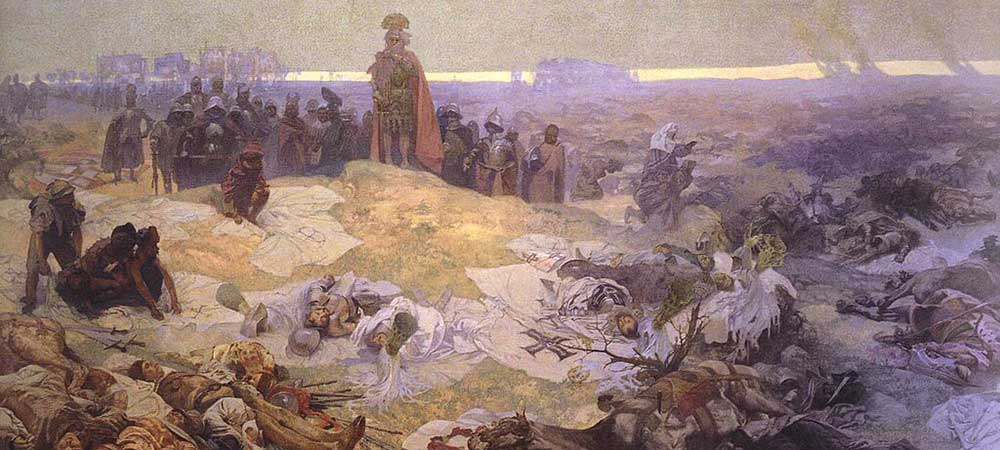
The aftermath of the Battle of Grunwald severely affected the Teutonic Order’s military and political stature. Casualty reports from the period indicate staggering losses, with conflicting figures ranging from 8,000 to 18,000 dead, pointing to the sheer brutality and scale of the conflict. Notably, the Order’s records show a drastic reduction in their ranks, with only a fraction of their forces returning to claim their pay at Marienburg. This decimation extended deeply into their leadership, with many key figures, including Grand Master Ulrich von Jungingen, killed during the battle. The loss of leadership created a vacuum and immediate disarray within the Order’s ranks, exacerbating their defeat.
In the immediate tactical aftermath, the Polish and Lithuanian forces captured several high-profile prisoners, including dukes and other nobility, who were later ransomed for considerable sums, further straining the Order’s resources. However, despite their decisive victory at Battle of Grunwald, the Allied forces needed to capitalize on their advantage. Their delayed approach to Marienburg allowed the Order time to fortify their capital and prepare a robust defense, ultimately staving off the siege. This delay underscored a missed strategic opportunity to decisively dismantle the Order’s power base.
Battle of Grunwald’s broader implications were felt over the subsequent years, reshaping the region’s geopolitical landscape. While resolving some territorial disputes, the Peace of Thorn in 1411 failed to deliver significant gains for Poland and Lithuania, highlighting the complexities of medieval diplomacy. However, the financial reparations imposed on the Teutonic Order sowed the seeds of long-term economic and political decline. Struggling under the weight of indemnities, increased taxes, and the cost of mercenary forces, the Order faced internal dissent and external pressures, eventually leading to significant territorial losses and the rise of the Prussian Confederation.
This shift marked the beginning of the end for the Teutonic Order as a dominant political and military force in the Baltic region. The Battle of Grunwald’s legacy, therefore, is not just one of a pivotal battle but of a turning point that significantly weakened one of medieval Europe’s most formidable military orders. It set the stage for the rise of statehood in Prussia and the consolidation of power by its neighboring monarchies.

